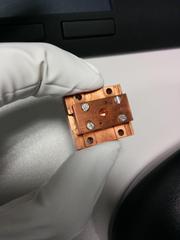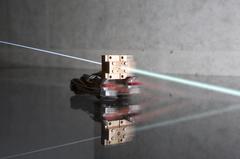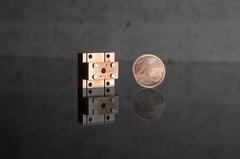URL: https://www.desy.de/news/news_search/index_eng.html
Breadcrumb Navigation
DESY News: Scientists create “Swiss army knife” for electron beams
News
News from the DESY research centre
Scientists create “Swiss army knife” for electron beams
DESY scientists have created a miniature particle accelerator for electrons that can perform four different functions at the push of a button. The experimental device is driven by a Terahertz radiation source and can accelerate, compress, focus and analyse electron bunches in a beam. Its active structures measure just a few millimetres across. The developers from the Center for Free-Electron Laser Science (CFEL) present their “Segmented Terahertz Electron Accelerator and Manipulator” (STEAM) in the journal Nature Photonics. Terahertz radiation is located between microwaves and the infrared in the electromagnetic spectrum.

The mini accelerator STEAM (centre) is driven by Terahertz radiation (yellow, coming from both sides). It can accelerator, compress, focus and analyse the incident electron bunches (blue). Credit: DESY, Lucid Berlin
This way, the scientists can control with ultra-high precision, what part of the Terahertz wave an electron bunch hits when it enters the device. Depending on the arrival time of the electron bunch, STEAM performs its different functions. “For instance, a bunch that hits the negative part of the Terahertz electric field is accelerated,” explains Zhang. “Other parts of the wave lead to focusing or defocusing of the bunch or to a compression by a factor of ten or so.” While compression means the electron bunch gets shorter in the direction of flight, focusing means it shrinks perpendicular to the direction of flight.

STEAM's housing is just centimetres across and easily fits between two fingers. The active structures inside are on a millimetre scale. Credit: DESY, Dongfang Zhang
Using Terahertz radiation also allows for the compact size of the STEAM device. “Terahertz radiation typically has a hundred times shorter wavelengths than the radio frequency radiation used in today's big particle accelerators. Therefore, all the structures in the device can shrink accordingly,” explains Kärtner, who is lead scientist at DESY and professor at Universität Hamburg. Measuring just about two centimetres on the largest side, STEAM easily fits into a matchbox. “And that's just the size of the housing. The active structures are on a millimetre scale,” adds Zhang.
The technology is still at an experimental stage. The developers see STEAM as a first step on the road to a future generation of compact, Terahertz driven particle accelerators. These could enable new applications and complement today's accelerators. Also, the pocket manipulator can already be utilised today: accelerator groups around the world are already considering it for bunch characterisation, as Kärtner points out: “STEAM can be used for future table-top accelerators, but its various functions are also interesting for existing machines.”
Reference:
Segmented Terahertz Electron Accelerator and Manipulator (STEAM); Dongfang Zhang, Arya Fallahi, Michael Hemmer, Xiaojun Wu, Moein Fakhari, Yi Hua, Huseyin Cankaya, Anne-Laure Calendron, Luis E. Zapata, Nicholas H. Matlis and Franz X. Kärtner; Nature Photonics (2018); DOI: 10.1038/s41566-018-0138-z

STEAM compared to a matchbox car. The direction of the electron beam is symbolised. Credit: DESY, Gesine Born

The complete device is only slightly larger than a two-Eurocent-coin. Credit: DESY, Gesine Born



